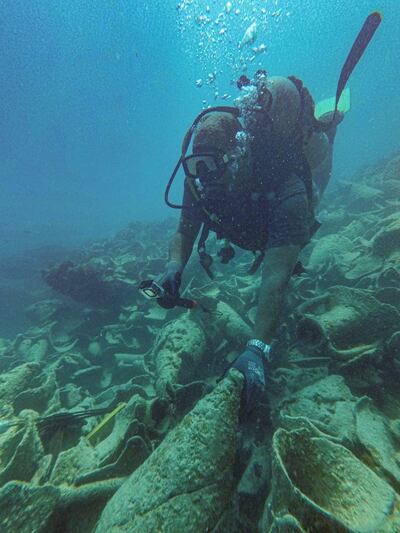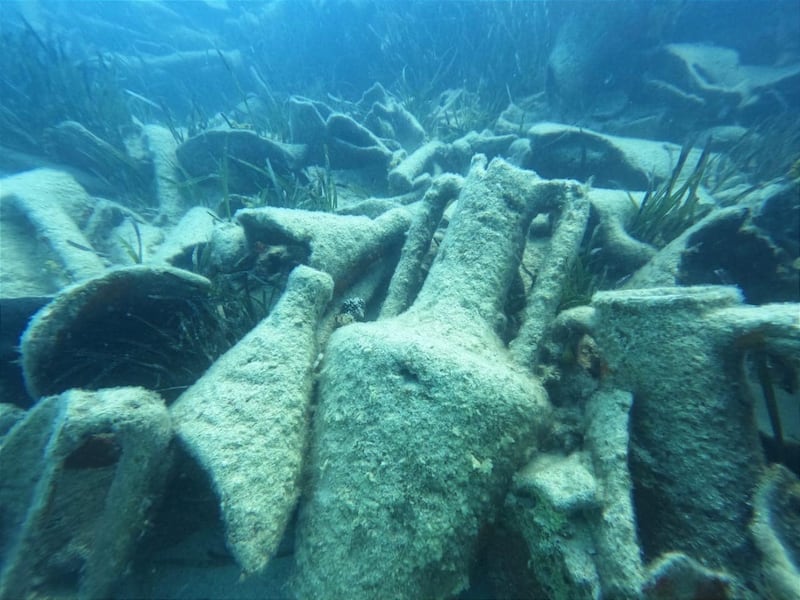The remains of an ancient sunken ship have been discovered in Mediterranean waters off the Egyptian coastal city of El Alamein by an archaeological mission, the country’s Tourism and Antiquities Ministry has said.
The find, which also included a number of clay jugs (amphoras), dates back to the 3rd century BC. The ship is believed to have been used to ferry wines between Greece and Egypt, according to a statement by Mostafa Waziri, the Secretary General of Egypt’s Supreme Council of Antiquities.
Pieces of broken wood from the ship and hundreds of pottery fragments were the first items discovered at the site during a recent sweep of the coastline, according to Ayman Ashmawy, the head of the council's Egyptian antiquities section.
Mr Ashmawy said the majority of the jars were found on an island that had subsided below sea level, which led archaeologists to conclude that the ship most probably sank after colliding with the island.
Following preliminary examinations of the artefacts, the vessel was determined to be a merchant ship.
The government was notified of the existence of the wreck by Hussein Mesharafa, an engineer and owner of a private marine survey company that recently conducted a survey of El Alamein's coast.

“This discovery highlights the commercial importance of the El Alamein region and Egypt’s northern coast in the third century BC, a time when there were many commercial ports in the area,” Mr Waziri said.
“Additionally, it provides scientific evidence of Egypt’s status in the region with regards to trade and tourism.”
Egypt’s north coast had some of the region’s busiest ports, which regularly received ships bringing goods from southern Europe that were then transported to other markets further south.
Goods such as wine, olives and grains were among the most prolifically traded items during the third century BC, according to the ministry’s statement.
Housing more than 30 commercial ports, villages and towns, Egypt’s northern coast was one of the world’s most popular trading routes in the 3rd century BC due to the prominence of the city of Alexandria.
Founded in 331 BC by Alexander the Great, the city went on to become one of the largest centres of Hellenistic civilisation, remnants of which can still be found today at museums and heritage sites throughout the city.
A Greco-Roman museum in Alexandria houses a large collection of relics dating back to its rule by the Greeks and then the Romans.
The Mediterranean waters in the area have also proven to be a prolific archaeological site with a large number of discoveries being made by archaeologists working along the length of Egypt’s 1,000km north coast.
Perhaps one of the most prominent sites is the Lost City of Thonis-Heracleon, which was discovered after a years-long search by French archaeologist Franck Goddio in 2000.
The city, which was found remarkably well-preserved, was one of the greatest port cities in the world and controlled all trade into Egypt.
Among the ruins of the city were 64 ships, 700 anchors, a treasure trove of gold coins, statues standing at 5 metres, and, perhaps most prominently, the remains of a huge temple to the god Amun-Gereb.
The discovery of the wreck, which highlights the historic ties between Egypt and Greece, was announced a few days after Greek Prime Minister Kyriakos Mitsotakis met Egyptian President Abdel Fattah El Sisi in the city of Alamein for bilateral talks.
The two countries have strengthened relations significantly in recent years.







